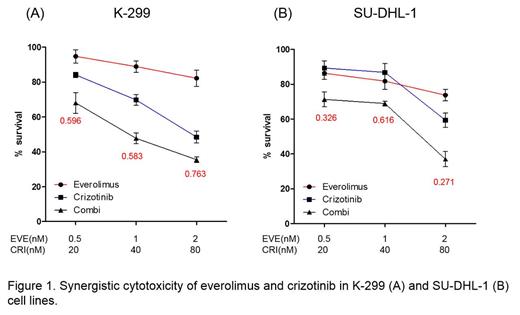Abstract
More than a half of anaplastic large cell lymphoma (ALCL) harbors an aberrant NPM-ALK fusion gene, which activates a number of down-stream signaling pathways such as Ras/ERK, PI3K/AKT, and JAK3/STAT3. Through this mechanism, mTOR pathway is also activated in ALK-positive ALCL (Vega F, et al. Cancer Res 2006). Everolimus, an mTOR inhibitor, has shown promising anti-tumor activity in a variety of lymphomas (Jundt F, et al. Blood 2005; Wanner K, et al. Br J Haematol 2006; Haritunians T, et al. Leukemia 2007), although the clinical efficacy of everolimus monotherapy was not satisfactory, possibly due to activation of several pro-surviving signaling pathways. The combined effect of everolimus and crizotinib, an ALK inhibitor, has not yet been investigated in ALK-positive tumors so far. The aim of this study was to evaluate the effect of everolimus in combination with crizotinib in ALK-positive ALCL cell lines, K-299 and SU-DHL-1.
We treated K-299 and SU-DHL-1 cells with various concentrations of everolimus and crizotinib at a fixed ratio of 1:40 (Figure 1). After 72 hours, the combination index (CI) values calculated by the Chou-Talalay method were less than 1 (range, 0.583-0.763 in K-299 cells and 0.271-0.616 in SU-DHL-1 cells) in all tested combinations, suggesting synergistic cytotoxicity of everolimus and crizotinib. The Western blot analysis (Figure 2) demonstrated that everolimus treatment up-regulated the phosphorylation of ERK Thr202/Tyr204 and AKT Thr308 and Ser473 in K-299 cells. However, this aberrant activation of ERK and AKT was attenuated by the addition of crizotinib. In addition, while everolimus selectively inhibited phosphorylation of mTOR Ser2448, a marker for mTORC1 activity, the combination treatment more potently inhibited mTOR Ser2448 phosphorylation and decreased phosphorylated mTOR at Ser2481, a marker for mTORC2, as well. In the cell-cycle analysis, the combination treatment induced G1 arrest. Everolimus treatment alone did not increase the fraction of cells in the sub-G1 region compared to the control (2.16% vs. 4.03% in K-299 and 1.34% vs. 1.68% in SU-DHL-1), while crizotinib monotherapy increased the sub-G1 population (11.88% vs. 4.03% in K-299 and 28.68% vs. 1.68% in SU-DHL-1). The combination of crizotinib and everolimus markedly increased the sub-G1 population in both ALK-positive ALCL cell lines (22.25% in K-299 and 46.40% in SU-DHL-1). PARP cleavage was also increased after the combination treatment. To test the hypothesis that our findings could be applyed to other ALK-positive malignancies, we treated NCI-H2228, a lung adenocarcinoma cell line that harbors an EML4-ALK fusion gene, with everolimus and crizotinib for 72 hours. The CI values were less than 1 in all tested combinations: 0.228 in 1 nM everolimus plus 80 nM crizotinib, 0.216 in 2 nM everolimus plus 160 nM crizotinib, and 0.349 in 4 nM everolimus and 320 nM crizotinib.
In summary, everolimus combined with crizotinib synergistically inhibited the growth of ALK-positive ALCL cells. Crizotinib abrogated aberrant ERK and AKT signaling activation induced by everolimus and more potently inhibited both mTORC1 and mTORC2 activity when combined with everolimus, resulting in increased G1 cell-cycle arrest and apoptosis (Figure 3). Our findings may provide an evidence for future research using everolimus and crizotinib combination in ALK-positive ALCL and could be used to improve the therapeutic outcome in patients with ALK-positive ALCL.
No relevant conflicts of interest to declare.
Author notes
Asterisk with author names denotes non-ASH members.




